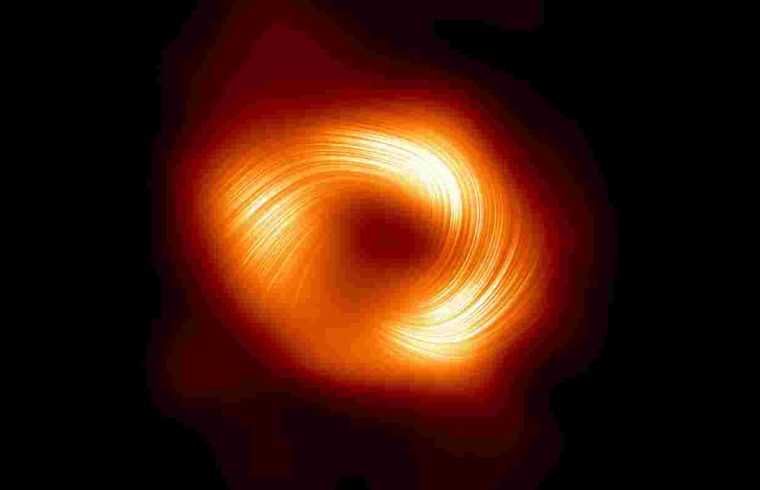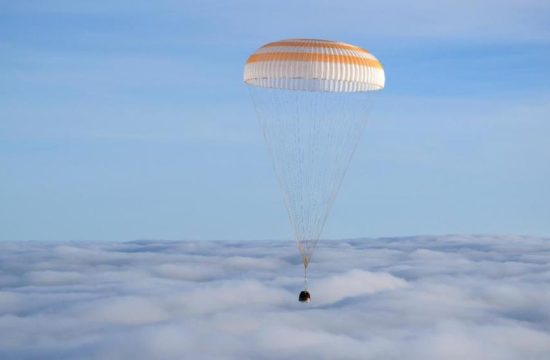
Swirling through the Milky Way’s central zone, surrounding the supermassive black hole Sgr A*, dust and gases constantly churn as energetic shock waves ripple.
An international scientific team using the Atacama Large Millimeter/submillimeter Array (ALMA) has sharpened our view of this action by a factor of 100, discovering a surprising new filamentary structure in this mysterious region of space.
Although the galaxy’s central molecular zone (CMZ) has long been known to be filled with swirling dust and gas molecules cycling through formation and destruction, the mechanism that drives this process has remained elusive. Molecules serve as tracers for various processes in molecular clouds, with silicon monoxide (SiO) particularly useful in detecting the presence of shock waves.
Using ALMA’s high resolution and sensitivity to map distinct spectral lines within the molecular clouds at the center of the Milky Way, the team led by Kai Yang (Shanghai Jiao Tong University) has delineated a new type of long, narrow filamentary structure at a significantly finer scale. The dynamic interaction between this turbulent environment and the slim filaments produced as shocks ripple through provides a more complete view of the cyclical processes within the CMZ.
“When we checked the ALMA images showing the outflows, we noticed these long and narrow filaments spatially offset from any star-forming regions. Unlike any objects we know, these filaments really surprised us. Since then, we have been pondering what they are,” Yang summarized.
These “slim filaments” were an unexpected, serendipitous find in the emission lines of SiO and eight other molecules. Their line-of-sight velocities are coherent and inconsistent with outflows. Thus, they do not fit the profile of other previously discovered types of dense gas filaments; furthermore, the filaments show no association with dust emission and do not appear to be in hydrostatic equilibrium.
“Our research contributes to the fascinating Galactic Center landscape by uncovering these slim filaments as an important part of material circulation. We can envision these as space tornados: they are violent streams of gas, they dissipate shortly, and they distribute materials into the environment efficiently”, said Xing Lu, a research professor at Shanghai Astronomical Observatory and a corresponding author of the research paper.
However, Yang’s team reports it remains unknown how these slim filaments initially arise, but shock processes emerge as a likely explanation. This inference is based on several key observations: the rotational transition of SiO 5-4 seen in ALMA observations, the presence of CH3OH masers, and the relative abundances of complex organic molecules in these slim filaments.
“ALMA’s high angular resolution and extraordinary sensitivity were essential to detect these molecular line emissions associated with the slim filaments and to confirm that there is no association between these structures and dust emissions,” emphasized Yichen Zhang, a professor at Shanghai Jiao Tong University and a corresponding author of the research paper. “Our discovery marks a significant advancement by detecting these filaments on a much finer 0.01-parsec scale to mark the working surface of these shocks.”
This breakthrough offers a more detailed view of the dynamic processes occurring in the CMZ and suggests a cyclical process of material circulation. First, shocks act as a mechanism to create these slim filaments, releasing SiO and several complex organic molecules such as CH3OH, CH3CN, and HC3N into the gas phase and the interstellar medium.
Then, the slim filaments dissipate to refuel the widespread shock-released material in the CMZ. Finally, the molecules freeze into dust grains, resulting in a balance between depletion and replenishment. If the slim filaments exist throughout the CMZ as abundantly as in this sample, there would be a cyclical balance between depletion and replenishment.
“SiO is currently the only molecule that exclusively traces shocks, and the SiO 5-4 rotational transition is only detectable in shocked regions with relatively high densities and temperatures. This makes it a particularly valuable tool for tracing shock-induced processes in the dense regions of the CMZ,” Yang said.
It is hoped that future ALMA observations covering multiple SiO transitions and census observations spanning the CMZ, combined with numerical simulations, will confirm the origin of the slim filaments and the possibility of the cyclic processes within this extraordinary region of the Milky Way.








